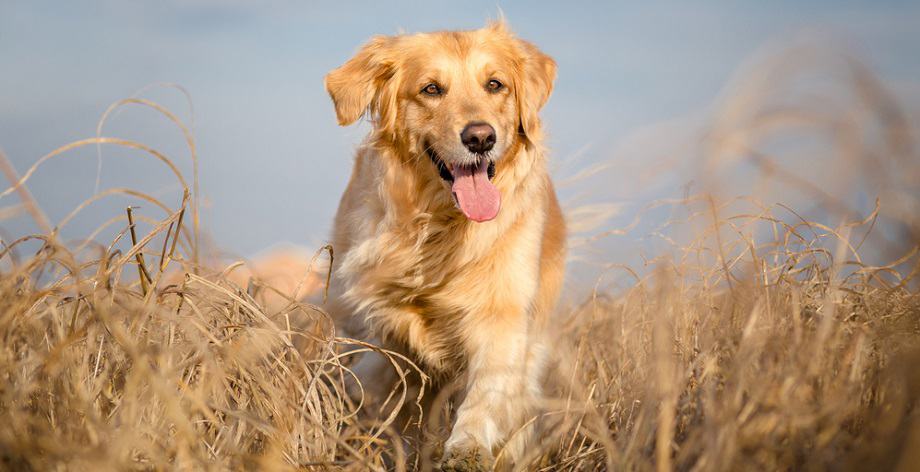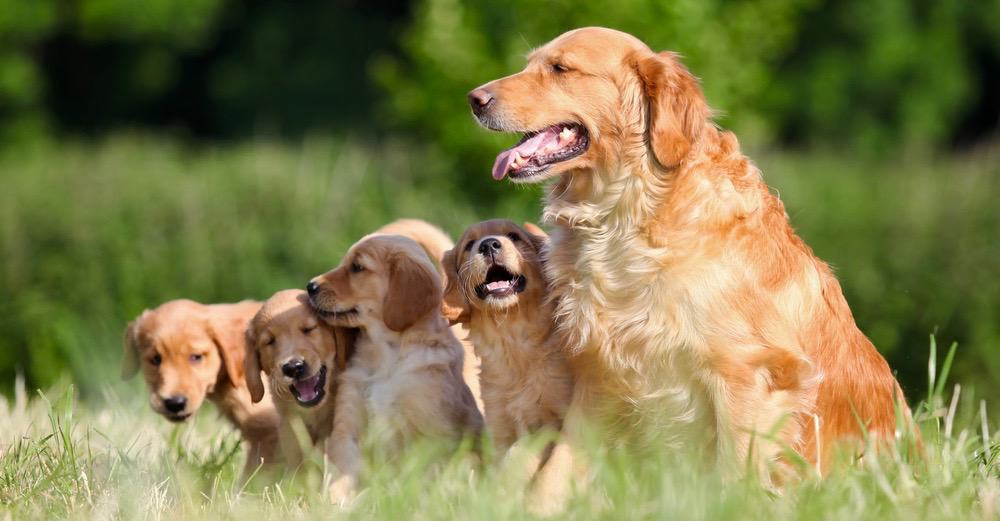Golden Retriever Growth Chart – Weight Chart & Size Chart
For your Golden Retriever to live a long and healthy life, their weight should always remain healthy.
The Golden Retriever growth chart will help you know the weight and height of your puppy at the different stages of their growth.
Golden Retrievers stop growing at the age of 18 months, where they reach their adult weight and height.
As an adult, a female Golden Retriever weighs between 55 and 65 pounds while a male Golden Retriever weighs between 65 and 75 pounds.
This article will give you more information about the growth of a Golden Retriever puppy, what to expect, and many more.
When Do Golden Retrievers Stop Growing?
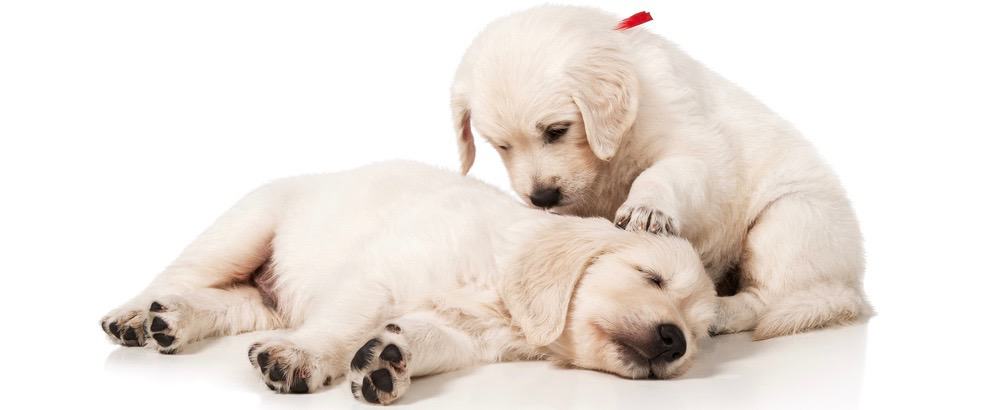
In this article, we’re going to go through the various stages of your Golden Retriever’s growth.
Since there are various stages of a puppy’s life—with both physical and cognitive development coming into play—it can be tough to really answer the question – when do Golden Retrievers stop growing?
However, in general, a Golden Retriever will stop growing when they reach the age of around 1.5 years—or 18 months old.
You can expect your pet to be at its full height and weight, (which you can follow in the Golden Retriever puppy growth chart), which is around 65-75 pounds for males and 55-65 pounds for females.
Golden Retriever Size Chart
To help you evaluate your Golden Retriever’s growth process, we’ve included this chart down below, separating the growing stages of both the male and the female Golden Retriever.
If you’re a first-time Golden Retriever owner, you’ll want to make sure you’re using the chart correctly, to be able to check whether or not your pup is hitting the average weight according to their age—or at the very least, hitting the minimum sizes.
On the left side of the chart, you’ll find the column dictating the age of your Golden Retriever, which can be measured in weeks.
Since the first seven weeks of your pup’s life are pretty standard and unpredictable in growing times, the chart first starts at this week number, where they should be reaching the standardized sizes.
At seven weeks, a Golden Retriever male puppy should be weighing at the very least 4 lb, whereas the female puppy actually has a bigger stature at a 5-pound minimum.
As the weeks progress, you’ll notice the minimum weight going up just a few pounds to even as much as almost 20 pounds at certain stages!
We would recommend consulting with your veterinarian about any particular questions you may have about your specific puppy’s size.
Golden Retriever Weight Chart (Female Puppy)
| Age | Smallest | Largest | Average |
|---|---|---|---|
| 7 Weeks | 5 lb - 2,26 kg | 17 lb - 7,71 kg | 9 lb - 4,08 kg |
| 8 Weeks | 5 lb - 2,26 kg | 17 lb - 7,71 kg | 10 lb - 4,53 kg |
| 9 Weeks | 8 lb - 3,62 kg | 17 lb - 7,71 kg | 12 lb - 5,44 kg |
| 10 Weeks | 10 lb - 4,53 kg | 22 lb - 9,97 kg | 15 lb - 6,80 kg |
| 11 Weeks | 12 lb - 5,44 kg | 25 lb - 11,33 kg | 17 lb - 7,71 kg |
| 3 Months | 16 lb - 7,25 kg | 33 lb - 14,96 kg | 22 lb - 9,97 kg |
| 4 Months | 22 lb - 9,97 kg | 44 lb - 19,95 kg | 30 lb - 13,60 kg |
| 5 Months | 25 lb - 11,33 kg | 52 lb - 23,58 kg | 40 lb - 18,14 kg |
| 6 Months | 27 lb - 12,24 kg | 61 lb - 27,66 kg | 43 lb - 19,50 kg |
| 7 Months | 31 lb - 14,06 kg | 67 lb - 30,39 kg | 45 lb - 20,41 kg |
| 8 Months | 40 lb - 18,14 kg | 70 lb - 31,75 kg | 52 lb - 23,58 kg |
Golden Retriever Weight Chart (Male Puppy)
| Age | Smallest | Largest | Average |
|---|---|---|---|
| 7 Weeks | 4 lb - 1,81 kg | 17 lb - 7,71 kg | 9 lb - 4,08 kg |
| 8 Weeks | 5 lb - 2,26 kg | 17 lb - 7,71 kg | 10 lb - 4,53 kg |
| 9 Weeks | 8 lb - 3,62 kg | 17 lb - 7,71 kg | 12 lb - 5,44 kg |
| 10 Weeks | 10 lb - 4,53 kg | 22 lb - 9,97 kg | 15 lb - 6,80 kg |
| 11 Weeks | 12 lb - 5,44 kg | 25 lb - 11,33 kg | 17 lb - 7,71 kg |
| 3 Months | 16 lb - 7,25 kg | 43 lb - 19,50 kg | 22 lb -9,97 kg |
| 4 Months | 25 lb - 11,33 kg | 44 lb - 19,95 kg | 30 lb - 13,60 kg |
| 5 Months | 27 lb - 12,24 kg | 57 lb - 25,85 kg | 40 lb - 18,14 kg |
| 6 Months | 29 lb - 13,15 kg | 72 lb - 32,65 kg | 44 lb - 19,95 kg |
| 7 Months | 32 lb - 14,51 kg | 77 lb - 34,92 kg | 48 lb - 21,77 kg |
Golden Retriever Growth Chart – What To Expect
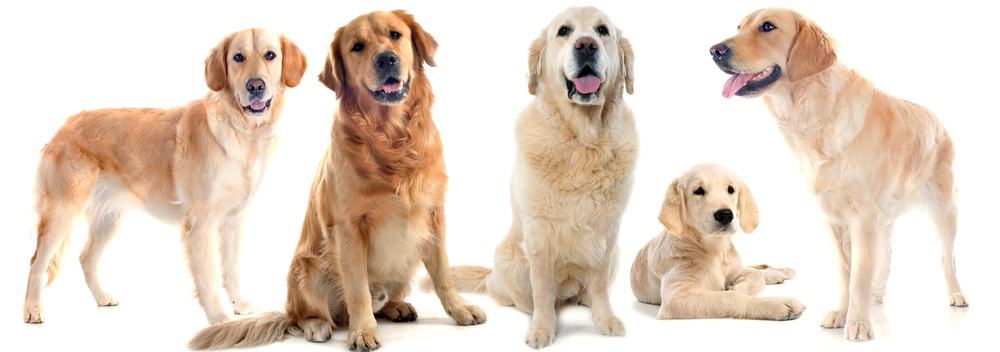
As your Golden Retriever grows, here are the different developmental stages you should be expecting— as seen in the Golden Retriever weight chart above.
Birth – 3 Weeks Neonatal
From birth to the first three weeks of their lives, your Golden Retriever will be in the neonatal stage, which will be quite a developmental stage in their lives. During this fragile period, the Golden Retriever is actually quite helpless in nature and should be kept with their mother.
No matter if your Golden Retriever is a female or male, your pup will typically be measuring under five pounds.
During this earlier stage of life, the pup will encounter various milestones, including learning how to open their ears and eyes, having their first baby teeth come through, and even learning how to crawl or walk awkwardly.
In every litter, there also tends to be the “runt” of the litter, which is the smallest one. This specific pup needs to be handled with care!
3 Weeks – 12 Weeks Socialization
During the socialization process, the Golden Retriever will start to explore and fill out its body as it finds its place in the world. This particular period in a Golden Retriever’s life is essential for its growth.
Although some breeders tend to keep the pup with his or her mother, there is some other speculation of letting them loose and into the wild for exploration (not really the wild, don’t worry).
During this period, the Golden Retriever will also start eating some solid foods and be able to play and start to house train! This is a very developmental period indeed!
From three to twelve weeks, a Golden Retriever can reach up to 22 or 23 lbs in size (depending on if the dog is female or male)!
3 Months – 6 Months Juvenile
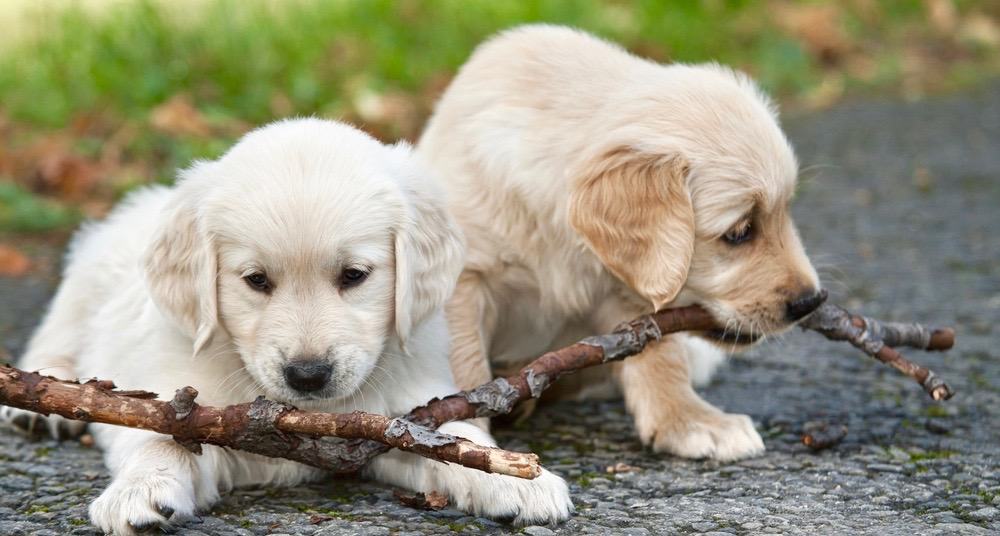
At this juvenile stage, the Golden Retriever is starting to learn about the world around him or her. The rapid growth phase will tend to slow down at this point in time in their development, indicating that they are pretty close to approaching a fully-developed size.
During this juvenile period, the pup will start to lose his baby teeth and will be ready to start training. This is a critical time in development where the dog can learn about fundamental behaviors like potty training and gaining clear and consistent rules for everyday life.
A Golden Retriever at this stage can reach 38 to 52 lbs—or even up to 75 lbs at its biggest!
6 Months – 16 Month Sexual Maturity
As your dog reaches sexual maturity, a Golden Retriever will grow to its full size during this period of development. If the dog has not been yet neutered or spayed, he will reach sexual maturity and entering heat cycles as well as mating behavior.
This can lead to territorial behavior. During this period, your dog will also start to grow quite quickly in his legs, ears, and nose.
This rapid growth in particular areas leaves the Golden Retriever quite vulnerable with their bones, which can lead to injury if not taken care of—which means that you should help your dog avoid excessive pressure on the joints.
As you can see in our Golden Retriever weight chart, your Golden Retriever can reach up to 90 lbs during this stage.
Adult
At the adult stage, above 16 months, most Golden Retrievers have reached full growth—however, some dogs even have some more growing to do!
There can be some leftover growing in a Golden Retriever’s development process all the way up to 2 years in age! During this period, you can expect your Golden Retriever to also develop a very specific and fixed personality.
You’ll be able to point out your dog’s likes and dislikes as well as expect certain behavioral responses. A fully grown pup can reach up to 90 lbs.
However, you can tell a lot about the size of your dog in accordance with their parents’ size! It’s a good indicator of what to expect when it comes to size.
Dangers Of Stunted Or Accelerated Growth
It is easy to worry about whether your golden retriever is growing too quickly or not quickly enough. Looking at a growth chart, you are seeing average growth rates that might not apply specifically to your puppy.
The dangers of stunted or accelerated growth are rare. Generally, puppies can experience stunted growth if they are malnourished during important phases of growth. If they have an illness or worms, they also might experience stunted growth.
Accelerated growth does not happen to the bones of the dog, but instead his weight. This is preventable because it is caused by overfeeding.
Do Golden Retrievers Still Grow After Being Neutered
A common question is whether your golden retriever will continue to grow after being neutered. This is not a simple question to answer. The short answer is that yes, your puppy can still grow after being neutered.
A longer answer is that you want to wait until your dog has fully grown before you neuter him. There has been recent information that has come about that has shown that dogs who are neutered before they are finished growing are more likely to develop hip dysplasia, arthritis, and, especially in golden retrievers, cancer.
If you wait, you will also not need to worry about whether your dog will continue to grow.
Golden Retriever Body Condition Score (BCS)

Body Condition Score is a measure used to determine the level of fat in pets including dogs. The scales used to measure BCS are1 to 9 and 1 to 5. Use visualization and palpation to assign a Body Condition Score to your Golden Retriever.
The ideal BCS for your Golden Retriever should be 5/9 or 3/5. This is where you can feel the ribs of your puppy with only a thin layer of fat covering them. With this score, the abdominal tuck and the waistline of your puppy is visible from the side and above, respectively.
How To Help Your Golden Retriever Lose Weight If He Is Overweight
Before helping your Golden Retriever lose weight, ensure that the weight gain is not caused by a medical condition. Once your vet has ruled out any conditions, you can help your puppy lose weight at home through the following steps:
- Food – reduce the amount of your you are feeding your puppy by about 10% and if the weight is not coming off, reduce the amount by another 10%. Ensure that the food you are feeding your puppy is high in quality and rich in nutrients.
- Exercise – start exercising your puppy with a slow 20-minute walk and then slowly increase the intensity once they are comfortable with it. Swimming is one of the best ways of exercising your puppy.
- Reduce treats – treats can add unnecessary weight to your puppy. Therefore, ensure that the treats are less than 10% of their food daily. You can also swap the treats for vegetables and fruits such as bananas, celery, and carrots.
How To Properly Weigh And Measure A Golden Retriever 
Weighing your Golden Retriever enables you to know how much food they should be eating daily and identify any signs of health conditions early. It is recommended that you weigh your puppy every six months to be able to monitor their weight to ensure it is ideal for their age.
To weigh your puppy at home, use your bathroom scale.
Step 1 – step on the scale and write down your weight.
Step 2 – step on the scale while holding your puppy and record the number.
Step 3 – subtract your weight from the weight of you holding your puppy. This is your puppy’s weight.
To measure the height, let your puppy stand next to a wall and find the withers, which is the highest point of your puppy’s shoulder blades. Use a measuring tape to measure from the ground to the withers. This is your puppy’s height.
What Is a Golden Retriever’s Neck Size?
Are you wondering what neck size your Golden Retriever is? Or maybe you want to buy a new collar for your puppy and are not sure what their neck size is?
Measuring your puppy’s neck is important to ensure that you find them a comfortable and secure collar that is not tight or loose for their neck. To measure your Golden Retriever’s neck, use a flexible and soft measuring tape.
Circle the measuring tape around the thickest part of your puppy’s neck and slide two fingers between the tape and your puppy’s neck. The measurement will be your puppy’s neck size.
On average, the neck size of a Golden Retriever is between 16 and 24 inches.
American vs Canadian vs British Golden Retriever
There are three recognized breeds of golden retriever: American, Canadian, and British.
- American Golden Retriever: This breed is usually less muscular and lankier than the other types. Their coats are normally darker and they come in shades of gold with feathering. They have a smooth gait.
- Canadian Golden Retriever: The Canadian golden retrievers are normally taller and leaner than the other breeds. They are the tallest type of golden retriever that you can get. Their coat is usually darker and their eyes are more triangular than round.
- British Golden Retriever: The British retriever is more muscular than the other varieties. They have thicker coats and normally weigh more. Their coat is lighter in color and sometimes is so light, that they are a soft cream color and even look white.These are still golden retrievers, though in American they are specially called English Cream golden retrievers. They are not commonly red or mahogany like the other breeds. They also have round dark eyes, which is a little different than other varieties. They are desired because of their happy temperament.
Factors That Affect Golden Retriever Puppy Growth
As your Golden Retriever pup gets older, you’ll notice that they’ll eventually stop growing. If you’ve noticed that your pup has not gotten to the particular milestones suggested in the Golden Retriever size chart, then you may want to consider the various factors in the different types.
Genetics
Just like with humans, Golden Retriever puppies will also be inheriting physical traits from their puppy parents! If you’re aware of the height or weight of your dog’s parents, then you can definitely have an idea of the size to expect when your dog is fully grown.
Although it’s not one hundred percent necessary to know your dog’s parents’ sizes, this can help eliminate any surprises!
Nutrition
Of course, nutrition can impact the puppy’s growth. If your Golden Retriever is not getting the proper nutrients—including vitamins, minerals, and various essential aspects like protein—then you may seem a stunt in growth, as your Golden Retriever doesn’t have the fuel he or she needs to reach their full height or weight.
This can also go the other way, with the possibility that a Golden Retriever is also getting overfed, where they then become overweight—especially if they’re not getting adequate exercise!
Physical Activity & Health
To help your pup stay at a proper weight for its size and age, you’ll need to make sure that you’re engaging him or her in regular activity. For a Golden Retriever, whether growing or fully grown, it’s important that they get at least one walk per day, but can definitely benefit from two!
Try and get your walks to be around a half-hour to an hour-long if you’re able to fit it into your schedule! This can also be beneficial for your health and activity level.
If you don’t have the time in your busy day, you can also consider hiring a dog-walker to get your pup the exercise it needs to be healthy and grow properly.
Golden Retriever Height
This type of breed has been regarded as medium to medium-large-sized dogs. However, the average height of a Golden Retriever can significantly be affected by not only genetics and your pup’s parents but also by their gender—and even where you live in the world!
There are different types of Golden Retrievers—for example, the American and the English. The English Golden Retriever is going to be bigger than the American Golden. In general, the Golden Retriever should reach a height of around 20-24 inches tall, depending on the gender.
How Long Are Golden Retrievers Pregnant?
The gestational period of a Golden Retriever will typically be around 63 days, plus or minus a few depending on your particular dog.
If your pregnant dog has not had their litter—despite showing certain symptoms like a body temperature drop, lack of appetite, restless, nesting or a visible puppy movement in the abdomen—then it might be time to visit your veterinarian to get the process going!
How Many Puppies Do Golden Retrievers Have?
If this is your first time becoming a Golden Retriever grandparent, you might want to know what you’re about to get into!
For a Golden Retriever, you’re going to expect the average litter size for this breed to be around eight puppies, but can vary from four to twelve for one litter!
However, there have been instances where a pregnant Golden Retriever has had as little as one puppy and as many as 17! Your veterinarian can definitely help you prepare better for a specific number.
What If Your Golden Retriever Is Overweight or Underweight
you’ve consulted the chart and have concerns about whether your Golden Retriever is over or underweight, there are a few steps to take to be able to evaluate your dog.
If your dog is at a healthy weight, then you should be able to easily feel his or her ribs. If your dog’s stomach has visible signs of sagging, that should mean there is too much fat on your dog’s body and appropriate measures (more exercise, less food) should be taken to help them get to a better weight.
Your dog should actually have a sort of “hourglass” figure. If there is no slight curve in your dog’s waist, that could mean that your pet is potentially overweight. A rounded face or visible folds of skin are also indications of an overweight Golden Retriever.
And finally, if your dog has a lack of desire for exercise and is extremely uncomfortable in warmer weather, this could mean that they are overweight.
On the other hand, if you can see your dog’s ribs and spine, has a severe abdominal tuck or have no fat at the base of his or her tail, these can be signs that they are underweight.
How Big Do Golden Retrievers Get?
Looking at the small size of a golden retriever puppy, it might be hard to imagine how big he will actually get. But, even the smallest puppies will get bigger.
When you look at the golden retriever growth chart, you will be able to follow along your puppy’s growth curve to get an idea of how big he will be once he is finished growing.
This is not exact, but as long as you are starting with an age 3 months or older, it should be about right. The sex of your puppy will also affect that as males are typically larger than females.
How To Keep Your Golden Retriever In Shape

Just like humans, your dog also needs to stay in shape to be healthy and grow properly, hitting all the necessary milestones when it comes to weight.
Developed originally as a sporting breed, the Golden Retriever was able to go through an entire day of hunting with no issues. This means that your dog’s exercise habits should show the same sort of energy.
When it comes to exercising regularly, your dog should be consistently exercising around 20-30 minutes, twice per day. This can help not only keep your pup healthy but help them expend any excess energy they may have pent up.
What Is The Life Expectancy Of Golden Retrievers?
If you’re the proud owner of a Golden Retriever, you can expect your pup to hang around for a good while.
Although the average life expectancy of a Golden Retriever isn’t as long as some of the smaller breeds. Typically, the Golden Retriever is expected to live anywhere from 10-12 years long!
Speaking of “long”—how long do golden retrievers grow? Golden Retriever males can be around 23 to 24 inches tall where females can reach around 21.5 to 22.5 inches tall.
How Much Does It Cost To Own A Golden Retriever?
With the upfront cost of a Golden Retriever being around $500-$2,000 from a breeder, you can expect to pay that price for the original purchase of your new dog.
However, this price may vary depending on where you get your dog from—which can vary if from a pet store or home breeder without AKC documentation.
Golden Retriever Genetics And Common Health Problems
The Golden Retriever is most known for having an average issue of the elbow and hip dysplasia—which is commonly seen in medium to larger breeds. This is where the femoral head partially dislocates and sometimes requires surgery.
Another common health problem is cancer, with the most common kinds as hemangiosarcoma, lymphosarcoma, mast cell tumors, and osteosarcoma.




